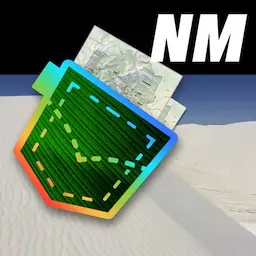"Chetro Ketl great kiva" by U.S. National Park Service , public domain
MammalsChaco Culture |
featured in
| National Parks Pocket Maps |  | |
| New Mexico Pocket Maps |  |
Chaco Culture
National Historical Park
National Park Service
U. S. Department of the Interior
Mammal List
ELK (CERVUS ELAPHUS) The elk herd
moved back into Chaco in the 1999.
Many opportunities arise to see the
estimated 60 resident elk throughout
the year. The best time to catch a
glimpse of the second largest cervid
in North America, howerver is in the
fall. Thanks to efforts made by the
state of New Mexico and private
individuals who strove to restore the
nearly extinct animal from 1910 to
1966, elk population estimates within
the state soar upwards of 72,000.
DESERT COTTONTAIL (SYVILAGUS
AUDUBONLI) The cottontail is one of
the most abundant mammals in
the park. You might get a
laugh seeing them sprawled
out in the summertime
around the parking lots and
prehistoric sites. Cottontails
conserve their energy and
moisture by avoiding activity in
the daylight hours. To provide
excellent warmth during the winter
months, the Chacoans wove cloaks
and blankets out of rabbit fur.
MULE DEER(OBDOCOLLEUS HEMIONUS) Mule
PORCUPINE (ERITHIZON DORSATUM)
This large rodent makes
periodical appearances
within the canyon.
Porcupines are
herbivores and love to
eat tree bark (having
the potential to strip
trees completely bare).
As with all animals in
the park, keep your distance
when viewing porcupines. They
don’t actually throw their quills, but
contact with the sharp objects can be
rather painful.
deer can be a little on the
shy side, but keep an eye
out for them around the
loop road and the washes.
Typically seen in the fall,
deer are most visible in the
early morning and late
afternoon. Population
estimates hover around 50,
but its exact size remains
unknown. The Chacoans utilized deer
bone for tools and ceremonial objects,
the meat for food, and hides for warmth.
COYOTE (CANIS LATRANS) These members
of the dog family are quite prevalent in
Chaco. You can see them running
down the road or prowling on top of
the mesas. If you’re lucky, you might
catch the unusual pairing of the
coyote and badger who often hunt
together. It might sound strange, but
this phenomenon has been reported
many times in the park especially around
the South Mesa. Many rock art panels feature
coyote images.
AMERICAN BADGER (TAXIDEA TAXUS)
The badger is an excellent
hunter and masters the skill
by digging lots of burrows
and capturing its prey with its
strong, sharp claws. Sometimes they will invade
another animal’s burrow,
wait for it’s return, and attack
the prey. You can see many
burrows along the South Mesa Trail
where you might see the earlier
described interaction with coyote.
Identify these mammals.
Have you seen any of these creatures in the park?
A.
(See reverse side for answers)
B.
C.
r/
d e on
O r mm
Co
m
Na
e
La
ORDER: ARTIODACTYLA
Elk
Mule Deer
ORDER:CARVIVORA
Coyote
Bobcat
Striped Skunk
Puma
American badger
Common grey fox
Black bear
Kit fox
tin
N
e
am
Ab
u
Cervus elaphus
Ocdoileus hermonius
nd
an
C
C
Canis latrans
Lynx rufus
Mephitis mephitis
Puma concolor
Taxidea taxus
C
U
U
U
U
Urocyon cinereoargenateus U
Ursus americanus
R
Vulpes macrotis
U
ORDER: CHIROPTERA
Pallid bat
Western lump-nosed bat
Big brown bat
Spotted bat
Silver-haired bat
Hoary bat
California myotis
Western small-footed bat
Long-eared myotis
Fringed myotis
Long-legged myotis
Yuma myotis
Big free-tailed bat
Western pipistrelle
Brazilian free-tailed bat
Antrozous pallidus
Corynorhinus townsendii
Epstisicus fuscus
Euderma maculatum
Lasionycteris noctivagans
Lasiurus cinereus
Myotis californicus
Myotis ciliolabrum
Myotis evotis
Myotis thysanodes
Myotis volans
Myotis yumanensis
Nyctinomops macrotis
Pipistrellus hesperus
Tadarida brasiliensis
/
er
ce
d
on
O r mm
Co
Na
me
tin
e
Ab
u
a
nd
ORDER: INSECTIVORA
Desert shrew
Notiosorex crawfordi
R
ORDER: LAGOMORPHA
Black-tailed jack rabbit
Desert cottontail
Lepus californicus
Syvilagus audubonli
C
C
Order: Rondentia
Antelope ground squirrel
Gunnison’s prairie dog
Ord’s kangaroo rat
Banner-tailed kangaroo rat
Porcupine
Colorado chipmunk
White-throated wood rat
Bushy-tailed wood rat
Stephen’s wood rat
N. grasshopper mouse
Plains pocket mouse
Silky pocket mouse
Brush mouse
Canyon mouse
Deer mouse
Pinyon mouse
Western harvest mouse
Spotted ground squirrel
Rock squirrel
Botta’s pocket gopher
C
U
R
R
U
R
C
C
U
C
U
U
R
C
U
La
m
Na
Ammospermophilius leucurus C
Cynomys gunnisoni
Dypodomys ordi
Dipodomys spectabilis
Erithizon dorsatum
C
C
C
C
Neotamias quadrivittatus
U
Neotoma albigula
C
Neotoma cinerea
U
Neotoma stephensi
U
Onychomys leucogaster C
Perognathus flavescens U
Perognathus flavus
C
Peromyscus boylii
U
Peromyscus crinitus
C
Peromyscus maniculatus A
Peromyscus truei
C
Reithrodontomys magalotis U
Spermophilis spilosoma R
Spermophilis variegatus R
Thomomys bottae
C
Legend
A = Abundant C = Common
R = Rare
U = Uncommon
Canyon Winged Friends
Pallid Bat
Fringed
Myotis
Big Brown Bat
Answers:
Chaco hosts a myriad of furry flying mammals. The
fringed and California myotis, Pallid bat, Big brown bat,
and Western Pipistrelle are some of the most commonly
seen bats in the canyon. No need to worry or fear the
creatures, since their diet consists mainly of insects. The
canyon walls serve as home to the host of bats found in
Chaco. If you stay overnight, you might see them flying
around at dusk or early evening. Ongoing studies continue to
identify the flying mammals. Two different means of identification are used including the netting and release of the creatures or the Anabat system which analyses the ultrasonic calls
of bats to identify the species.
A. Antelope Ground Squirrel B. Kangaroo Rat C. Black-Tailed Jack Rabbit
(for reverse side)
EXPERIENCE
YOUR
AMERICA
nc
e


